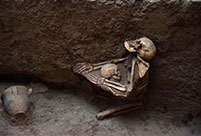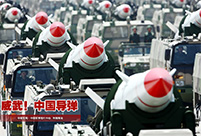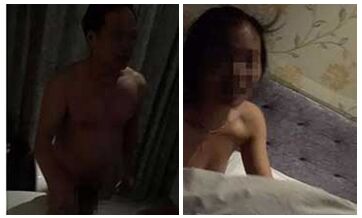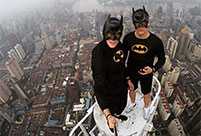

| Simuwu Ding(File photo/National Museum of China) |
BEIJING, Aug. 15 -- The four-legged rectangular colossus stands as a national icon in an exhibition hall in China's National Museum in Beijing.
The world's heaviest bronze item Simuwu Ding, weighing 832.84 kilograms, was crafted by the finest smiths as a burial tribute, commissioned by a young prince to his dead mother some 3,000 years ago.
A "ding" was originally a cooking vessel to boil meat in ancient China. It became a ritual vessel in the Shang Dynasty (16th-11th Century BC), and a symbol of social rank --- the bigger the ding, the more important the owner.
The fortunes of the Simuwu Ding, which were unearthed in a civilian ancestral graveyard during the Chinese war against Japanese invasion in the 1930s and 1940s and hidden for fear it would be looted, mirrors the modern history of China.
DISCOVERY
From 1894, the Western powers, with their armed incursions into China, looted and damaged a vast amount of cultural relics and treasures. The burden of defending the country's heritage fell mainly on civilians.
In March 1939, Wu Peiwen, then 18, with a group of villagers of Wuguan, Anyang city, Henan Province, spent several nights digging up the ding from a few meters below his family burial plot. They were unaware of its ancient origins. Because it looked like a manger, they called it "the manger-shaped ding".
Japanese troops attacked the Lugou Bridge, also known as the Marco Polo Bridge, on the outskirts of Beijing on July 7, 1937, triggering China's full-scale resistance against Japanese aggression. Four months later, Anyang was occupied.
The Japanese began a frenzied slaughter on taking the city. Records show that on Nov. 4, the first day of their occupation, the occupiers killed more than 1,000 civilians. In the next few days, 2,299 people in Anyang County were killed or wounded. The city-wide death toll over the course of the war was 127,300.
Along with the Japanese soldiers also came so-called "scholars", who began looting Chinese relics.
The Chinese government has estimated that the Japanese invaders stole more than 3.6 million cultural relics and damaged 741 historic sites from 1931 to 1945. Chinese scholars regard it as the "biggest cultural loss in history".
"At least 50,000 oracle pieces were lost overseas, and 35,000 were taken to Japan," says Tang Jigen, a researcher at the Institute of Archaeology of the Chinese Academy of Social Sciences, "and that is a very, very conservative estimate."
Wu Peiwen, the only boy in his family, wanted to stop the Japanese from seizing the ding, but he feared the consequences if he was caught hiding it in his home. He and other villagers agreed to sell it.
An antique dealer agreed to buy it, but asked Wu to break it up and deliver the pieces to Beijing. Wu tried many times with saws and hammers, but only managed to cut off the handle.
However, informants soon leaked news of his discovery to the Japanese army, who searched Wu's house and yard. They found nothing as they never imagined that Wu would bury the ding in his stable and cover the ground with cow dung, weeds and other rubbish.
Wu Su'an, Wu Peiwen's grandson, recalls that his grandfather once said he had prepared for the worst. He kept the handle at his cousin's home. If he were killed and the ding taken by the Japanese, following generations would have it as evidence of the theft after the war.
To escape suspicion, Wu Peiwen went south to Anhui Province, and then to Nanjing city of Jiangsu Province, where he worked as a miner for the next decade.
After Japan surrendered on Aug. 15, 1945, Kuomintang (KMT) leader Chiang Kai-shek ordered to build a national museum in Nanjing. In 1946, the KMT army stationed in Anyang dug up the ding from Wu's house and presented it to Chiang as a 60th birthday gift. Chiang put it on public display in 1948 and its photo was splashed all over the newspapers.
Wu didn't see the ding in Nanjing, but he was proud when other workers acknowledged his defense of the treasure.
When retreating to Taiwan in 1949, Chiang took many relics, but left behind the Simuwu Ding.
In 1959, the ding was delivered to Beijing's national museum and archaeologists refixed the broken handle and fully restored the ding to its original two-handled glory.
RENAME
In 2011, scholars argued the ding should be renamed the Houmuwu Ding - "hou" means queen in Chinese - as it was a tribute vessel that represented a son's grief at the loss of his mother.
Tang Jigen says sacrifice tributes were common in the Shang, when people believed the dead could bless the living.
Yinxu, capital of the later Shang, is now home to a China's oldest archaeological site. Located in the north of Anyang, it successfully applied for World Heritage Site status in 2006. The ding played an important role in that decision.
"It is a masterpiece of the high bronze craftsmanship 3,000 years ago, and strong evidence of a dynasty and its culture of which very little has been recorded," says Tang, who leads the Yinxu archaeological team.
It was 67 years later that Wu Peiwen was able to touch the ding again, when it was put on display in Anyang in 2006. He lived to see his former home protected and to receive a reward of 2,000 yuan before he died the same year.
AMBITION
Today, the Houmuwu Ding is an often-replicated cultural icon of Anyang. In front of almost all official buildings stands a bronze ding. Local banks, hotels and museums incorporate it in their logos.
The ding has also become a Chinese icon to mark great events. In 2007, China forged a "Ding of the Century" to present to the United Nations. The "Seeking Truth From Facts Ding" on a square in Guang'an, Sichuan Province, commemorates the centenary of Deng Xiaoping's birth. A farmer donated a "Farewell to the Land Tax Ding" to China's National Agricultural Exhibition Center to celebrate the abolition of agricultural taxes.
Wu Su'an runs a factory producing bronze replicas. Now his main business is publishing comic books and films about his grandfather's story.
His ambition is to build a hotel which will be shaped like the Houmuwu Ding, with elevators running up and down its four legs.
"My grandfather said the great contribution he made during his life was that he didn't give the ding to the Japanese," says Wu Su'an.
 Striking moments when strategic missiles are launched
Striking moments when strategic missiles are launched Construction on Asia’s biggest suspension bridge started
Construction on Asia’s biggest suspension bridge started Impressive firing of China’s rocket artillery system
Impressive firing of China’s rocket artillery system Shocking scenes found in 4000-year-old earthquake relic
Shocking scenes found in 4000-year-old earthquake relic Female soldiers add color to military parades
Female soldiers add color to military parades Mums stage breastfeeding flash mob
Mums stage breastfeeding flash mob Awesome Chinese missiles
Awesome Chinese missiles Official shot having sex with two college girls
Official shot having sex with two college girls Moscow “spider-man” climbs Chinese skyscraper
Moscow “spider-man” climbs Chinese skyscraper After the blasts
After the blasts PC slump drags Lenovo down
PC slump drags Lenovo down Rein in carping queries in wake of blasts
Rein in carping queries in wake of blasts Police officers punished after prisoner sold drugs from behind bars
Police officers punished after prisoner sold drugs from behind barsDay|Week